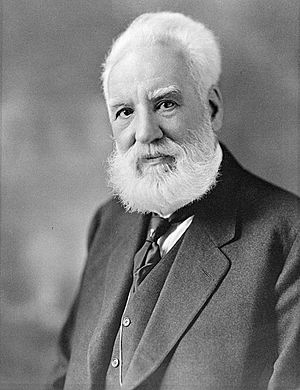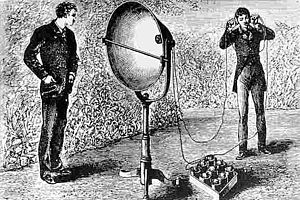Alexander Graham Bell facts for kids
Quick facts for kids
Alexander Graham Bell
|
|
|---|---|

Bell c. 1917
|
|
| Born | March 3, 1847 |
| Died | August 2, 1922 (aged 75) Beinn Bhreagh, Nova Scotia, Canada
|
| Citizenship | United Kingdom (1847–1922) British-subject in Canada (1870–1882) United States (1882–1922) |
| Alma mater | |
| Occupation |
|
| Known for | Invention of the telephone b |
| Spouse(s) |
Mabel Hubbard
(m. 1877) |
| Children | Four c |
| Parent(s) |
|
| Relatives |
|
| Awards |
|
| Signature | |
| Notes | |
|
|
Alexander Graham Bell (March 3, 1847 - August 2, 1922) was a famous teacher, scientist, and inventor. He is best known for inventing the telephone. He also helped start the Bell Telephone Company.
Contents
Early Life and Family Background
Alexander Graham Bell was born in Edinburgh, Scotland. He had two brothers, Melville and Edward, who both died young from tuberculosis. His father, Alexander Melville Bell, was a phonetician, which means he studied speech sounds. His mother was Eliza Grace Bell.
When he was 10, Alexander asked his father for a middle name, like his brothers. For his 11th birthday, his father let him choose "Graham." This name was chosen to honor Alexander Graham, a family friend from Canada. To his close family, he was always known as "Aleck."
Family's Focus on Speech
Bell's family was well-known for teaching people how to speak clearly. Both his grandfather and his father taught elocution, which is the art of clear speaking. His father also invented and wrote about something called Visible Speech. This system helped teach people who were deaf or unable to speak how to form words by watching lips and understanding sounds.
Alexander and his brothers learned Visible Speech very well. They could even figure out sounds for different languages just by looking at the symbols. This amazed audiences during his father's public shows.
Bell's Mother and Hearing
From a young age, Bell loved art, poetry, and music. He learned to play the piano without formal lessons. He was also deeply affected by his mother's gradual deafness, which started when he was 12. He learned a manual finger language to communicate with her silently. He also found a way to speak directly into her forehead in clear tones, which helped her hear him better. His mother's hearing loss made him very interested in acoustics, the science of sound.
First Invention as a Child
As a child, Bell was very curious and loved to experiment. His best friend, Ben Herdman, lived near a flour mill. When Bell was 12, he invented a simple machine to remove husks from grain. This machine used rotating paddles and nail brushes. It was used at the mill for several years. In return, Ben's father gave the boys a small workshop to invent things.
Education and Learning
Bell was taught at home by his father for a while. Later, he went to the Royal High School in Edinburgh. He left school at 15, and his grades were not very good. He was mostly interested in science, especially biology.
After leaving school, Bell lived with his grandfather, Alexander Bell, in London for a year. During this time, he developed a love for learning. His grandfather helped him learn to speak clearly and confidently, which was important for Bell's future as a teacher.
At 16, Bell became a "pupil-teacher" at Weston House Academy in Elgin, Moray, Scotland. He taught elocution and music. The next year, he attended the University of Edinburgh. In 1868, he was accepted into University College London.
Early Sound Experiments
Bell's father encouraged his interest in speech. In 1863, they saw a "mechanical man" that could simulate a human voice. Bell was fascinated. He and his older brother Melville decided to build their own version. Their father promised a "big prize" if they succeeded.
While his brother built the throat, Bell worked on the skull. They created a lifelike head that could say a few words. When they blew air through its "windpipe" and adjusted its "lips," it clearly said "Mama." Neighbors were amazed by their invention.
Bell continued his experiments with his family's dog, Trouve. He taught the dog to growl and then manipulated its mouth and vocal cords. He could make the dog sound like it was saying, "How are you, grandmama?" People who saw this were convinced they saw a "talking dog."
Moving to North America
In 1870, at age 23, Bell and his family moved to Canada. They settled in Brantford, Ontario. Bell began studying communication machines. He even made a piano that could send sounds far away using electricity.
In 1871, he went to Montreal, Quebec, where he taught about "visible speech." His father was asked to teach at a large school for deaf people in Boston, Massachusetts, but he gave the job to Alexander. Bell started teaching there in 1872. He became well-known in the United States for his work with deaf people. He published many writings about it. Because of his efforts, many deaf people in the United States of America learned to speak.
Founding Telephone Companies
In 1876, Bell was the first inventor to get a patent for the telephone. He helped start the Bell Telephone Company in July 1877. This company later merged with others to form larger companies, including the American Bell Telephone Company in 1880 and American Telephone and Telegraph Company (AT&T) in 1885. AT&T is still a very large company today. Bell also helped form the Oriental Telephone Company in 1881 with Thomas Edison.
Bell's Inventions
Alexander Graham Bell held 18 patents on his own and shared 12 patents with others. These patents covered many inventions, including:
- 15 for the telephone and telegraph
- 4 for the photophone
- 1 for the phonograph
- 5 for aeronautics (flying machines)
- 4 for hydrofoils (boats that lift out of the water)
- 2 for a selenium cell (used in light sensors)
The Telephone's Invention
In 1874, Bell was working on a "musical telegraph." This device used electricity and a magnet to make an iron reed vibrate. One day, a reed stopped working. Bell asked his assistant, Thomas Watson, to pluck the reed at the other end of the line. To Bell's surprise, he heard the reed at his end vibrate and make the same sound, even without electricity.
This discovery showed him that a moving reed could create changes in a magnetic field, which could then make another reed vibrate. This gave him the idea that the complex vibrations of speech could be turned into electrical currents. These currents could then reproduce speech far away.
Bell and Watson designed a receiver. It had a stretched film or drum with a small piece of magnetized iron attached to it. This piece could vibrate in front of an electromagnet. They finished this device on June 2, 1875.
A few days later, they tried two receivers together. One was in Bell's room, and the other was in the cellar. Bell spoke into his instrument, "Do you understand what I say?" Watson rushed upstairs and said, "Yes!"
The first successful two-way telephone call happened on March 10, 1876. Bell spoke into his device, "Mr. Watson, come here, I want to see you." Watson replied and came into the room. The first long-distance call was made on August 10, 1876. Bell called Watson from his family home in Brantford, Ontario, to Paris, Ontario, about 10 miles (16 km) away.
On March 7, 1876, the U.S. Patent Office gave Bell patent #174465 for the telephone.
The Photophone
Bell and his assistant, Charles Sumner Tainter, also invented a wireless telephone called a photophone. This device could send sounds and human conversations using a beam of light.
On June 21, 1880, Bell's assistant sent a wireless voice message a good distance. It went from the roof of the Franklin School in Washington, D.C., to Bell's laboratory window, about 213 meters (700 feet) away. This happened 19 years before the first voice radio transmissions.
Bell believed the photophone was his "greatest achievement." He told a reporter that it was "greater than the telephone." The photophone was an early version of the fiber-optic communication systems we use all over the world today.
Metal Detector
Bell also invented an improved metal detector in 1881. This device made sounds when it was near metal. He quickly put it together to try and find a bullet in the body of U.S. President James A. Garfield. The metal detector worked, but it couldn't find the bullet because of the metal bedframe the President was lying on. Bell later shared details of his experiments in a paper in August 1882.
Personal Life and Death
Bell married Mabel Hubbard on July 11, 1877. Mabel was deaf, just like his mother. They had four children:
- Elsie May Bell (1878–1964)
- Marian Hubbard Bell (1880–1962), called "Daisy"
- Two sons who died as babies (Edward in 1881 and Robert in 1883)
Alexander Graham Bell died from diabetes at his home near Baddeck, Nova Scotia, in 1922.
Honors and Recognition
- In 1888, he was one of the first members of the National Geographic Society. He later became its second president.
- The French government gave him the Legion of Honor award.
- The Royal Society of Arts in London gave him the Albert medal in 1902.
- The University of Würzburg, Bavaria, gave him a Ph.D. degree.
Alexander Graham Bell Quotes
- "Concentrate all your thoughts upon the work at hand. The sun's rays do not burn until brought to a focus."
- "Before anything else, preparation is the key to success."
- "A man, as a general rule, owes very little to what he is born with - a man is what he makes of himself."
- “The inventor...looks upon the world and is not contented with things as they are. He wants to improve whatever he sees, he wants to benefit the world; an idea haunts him.”
Interesting Facts About Bell
- Alexander Graham Bell’s mother and wife were both deaf.
- He asked his father for a middle name for his eleventh birthday because his brothers had one.
- Alexander thought the photophone was a greater invention than the telephone.
- He didn't like having a telephone in his study because he found it distracting.
- His home had an early form of air conditioning. Fans blew air over large blocks of ice.
- Alexander helped Helen Keller’s father find the Perkins School for the Blind. There, Helen met and hired Anne Sullivan, her famous teacher.
- Bell helped create the National Geographic Society.
- Bell helped guide the first controlled plane flight in Canada, the Silver Dart.
- In 1919, Bell invented the world’s fastest speedboat. It set a speed record of 70.86 miles per hour.
Images for kids
-
Melville House, the Bells' first home in North America, now a National Historic Site of Canada
-
Bell, top right, providing teaching to teachers at the Boston School for Deaf Mutes, 1871. He always called himself "a teacher of the deaf."
-
An actor playing Bell in a 1926 film holds Bell's first telephone transmitter
-
Bell statue by A. E. Cleeve Horne in front of the Bell Telephone Building of Brantford, Ontario, known as The Telephone City.
-
A quote by Alexander Graham Bell carved in stone at the Peace Chapel of the International Peace Garden.
-
Bell, who attended the University of Edinburgh, Scotland, receiving an honorary Doctor of Laws degree (LL.D.) in 1906.
See also
 In Spanish: Alexander Graham Bell para niños
In Spanish: Alexander Graham Bell para niños

















